James Maliszewski: The Tékumel Interview
June 4, 2022 rpgs tekumel interview
For awhile now, I’ve wanted to talk to James Maliszewski of Grognardia fame of his experience playing and running a seven year campaign of Empire of the Petal Throne. EPT has long been a fascinating game for many RPG fans due to how early on in the scene it was created and because of the depth of the lore designed by its creator MAR Barker. More recently it has come into the news since it turns out Barker had pseudonymously written a neo-nazi propaganda novel. I wanted to talk to James about Tekumel, long campaigns, Barker and his tainted legacy, and where true ownership of an RPG setting lies. James was very kind to grant me this interview and I really appreciate what he had to say.
Sean McCoy: So first off: Tékumel is sort of a cult object in D&D circles. I tend to be extremely attracted to this kind of hard to get material, as I imagine a lot of OSR adjacent people are. Your blog alone is a huge catalogue of rare, hard to find “hidden gems.” What I’m getting at is Tékumel, to me, is the crown jewel of hidden gem RPGs. Can you speak to that a bit and what drew you to Tékumel and Empire of the Petal Throne (EPT) initially?
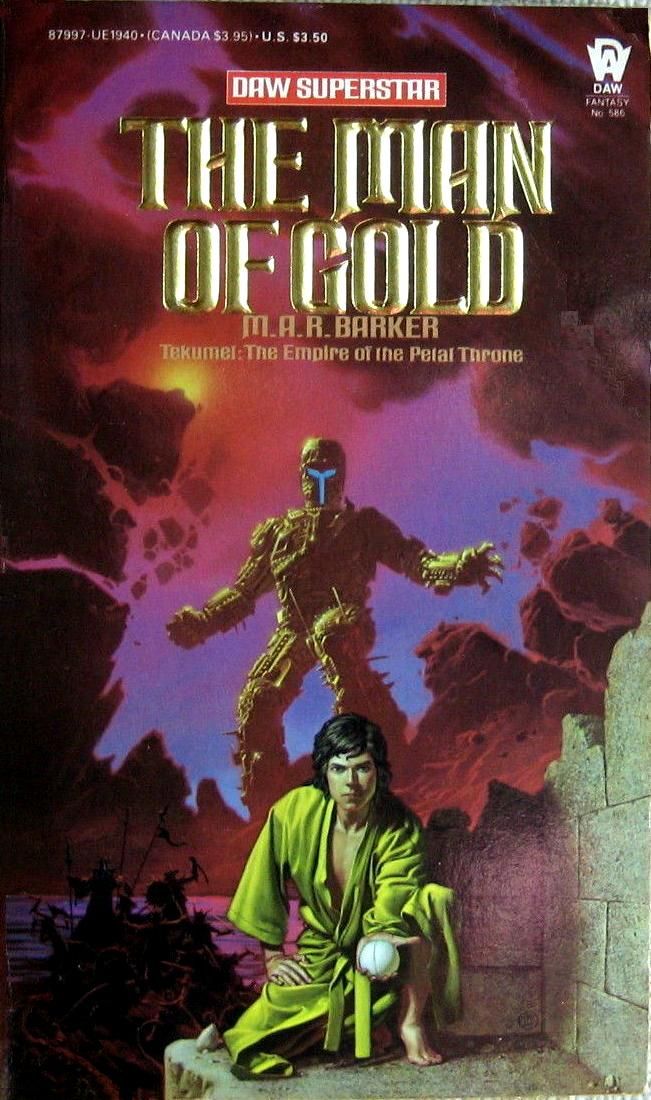 The Man of Gold by MAR Barker
The Man of Gold by MAR Barker
James Maliszewski: It wasn’t long after I started playing D&D in late 1979 that I first heard people, usually by older gamers I’d meet in hobby shops, talk about Empire of the Petal Throne and Tékumel. At that point, EPT was no longer easily available — I didn’t see a copy until the 1990s — and I never met anyone who was actively playing in Tékumel. Even so, I kept running into people who’d mention them both as being “incredibly detailed” and “hard to understand.” There was definitely an aura of mystery about Tékumel, one that only slightly began to disappear for me when I read the novel Man of Gold, probably in 1985 or ’86. Man of Gold planted the first real seeds of my interest in Tékumel, since I now at least had some sense of what the setting was like in broad terms. What immediately struck me were two things: Tékumel was a unique world that didn’t ape Tolkien’s Middle-earth and it included this hidden foundation of science fiction beneath its fantasy veneer. I’ve always been more of a SF guy than a fantasy one, so this really intrigued me and it’s what ultimately led me to seek out more information about the setting (though it wouldn’t be till the early ’90s that I was actually successful in doing so).
SM: Tékumel’s unique world is definitely its calling card. What fascinates me is that if you squint it could very easily have been a supplement for OD&D much like Greyhawk and Blackmoor. It shares all the familiar tropes: baseline D&D, some new rules, and a very specific campaign world based on play (rather than as a product). What do you think about that? Is EPT a “lost” supplement? How does it differ from mainline D&D?
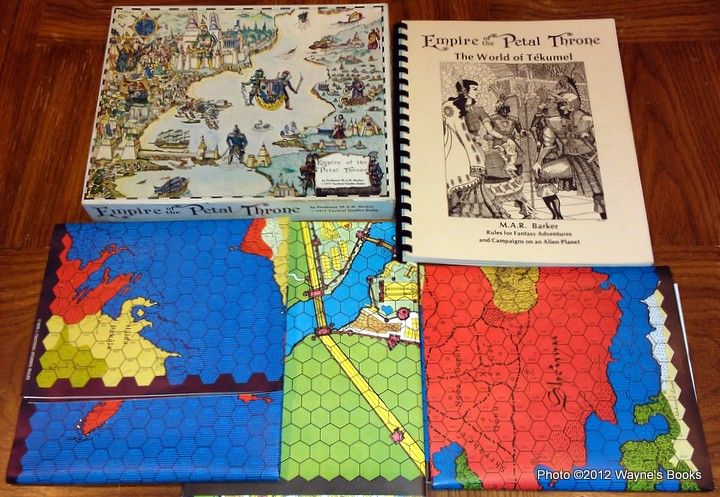 Empire of the Petal Throne
Empire of the Petal Throne
JM: I think you’re definitely on to something. The mechanical differences between OD&D and EPT are relatively few: percentile ability scores rather than 3d6 and a different way to handle spellcasting. In terms of approach to the campaign setting, though, they’re, no pun intended, worlds apart. Tékumel, even in its earliest presentation, much more intentionally immersive than anything published for any version of D&D until (maybe) the early 1990s. EPT places great emphasis on Tékumel’s fictional societies and cultures, with the goal that the players, like their freshly arrived barbarian characters, would eventually “go native” and view the setting on its own terms rather than through the lens of gaming. That’s why there’s so much detail about the customs and beliefs of the Tsolyáni Empire, not to mention languages and writing systems.
SM: This rich Tsolyáni culture I think is the heart of what makes the world so appealing to do many people. I love to travel, I love learning new languages and truly visiting another world is one of the great appeals of roleplaying to me. I love D&D but often times I find myself playing in a sort of kitchen sink fantasy setting where there just isn’t that much interesting to learn about the world. On the other hand, the barrier to entry for EPT feels very high. How have you managed learning all the Tékumel lore?
JM: Slowly — and mostly through play. Tékumel can appear overwhelming from the outside, because of how much detail there is and how different that detail is from the kind of vanilla fantasy normally associated with D&D. However, it’s been my experience that there are only a handful of Big Picture essential details you need to know when you start playing in Tékumel, like, for example, the scarcity of iron or the clan-based social structure to name two. Everything else can be learned (and added) as you become more comfortable with the major details — at least that’s what I did.
SM: I remember a story about MAR Barker where someone (maybe you?) writes him a letter asking what they’ll find in such and such corner of the world. Barker relies “why don’t you go there and let me know what you find?” I think there’s an initial hurdle for a lot of referees that Tékumel is a finished place so to speak. And if they start moving things or changing things they’ll find they have inadvertently painted themselves into a corner. Have you ever run into that feeling?
JM: Yes, that story is mine. Now, I understand the feeling that Tékumel is this finely wrought tapestry and that, if you pull too hard on one of its strands, you risk unraveling the whole thing. I can assure you it’s not true. There are many, many “blank” spaces in the setting where a referee can place his own creations without too much fear of “destroying” the setting. This is true even in well established places like Tsolyánu, because it simply would have been impossible for anyone to have filled in all the blanks. Things come up in play for which there are no established answers and each referee needs to decide, based on his reading of the existing material, what works best in his own campaign. As I said, I understand the anxiety about “doing it wrong.” That’s mostly a testament to how well presented Tékumel is; there’s a false impression that it emerged fully formed from the head of Barker. In reality, he regularly reworked and re-contextualized his initial ideas, which is what individual referees should do too.
SM: That’s great to hear. So what are some of the ways that players interact with Tékumel and how does it differ from other RPGs? What do you do in Empire of the Petal Throne?
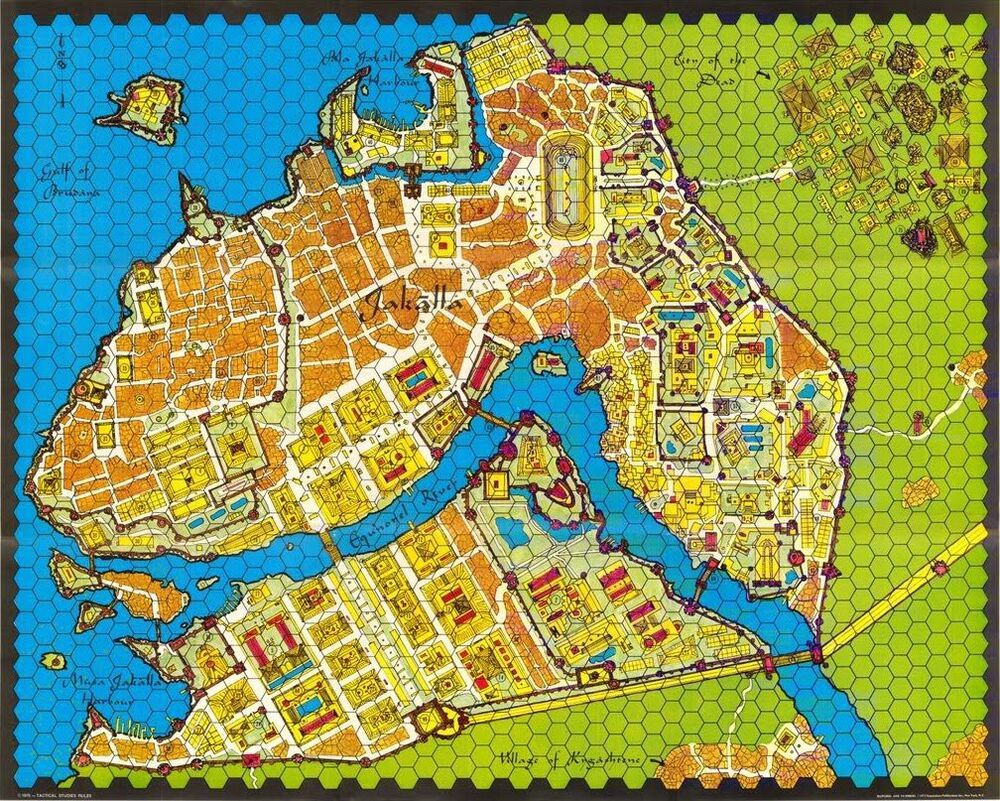 Map of Jakalla from Empire of the Petal Throne
Map of Jakalla from Empire of the Petal Throne
JM: The flippant answer is “Anything that interests you.” The more serious answer is twofold. EPT mentions that most of the major inhabited cities of Tékumel are built atop older cities, going back centuries, if not millennia. Those older cities now form the basis for the “underworlds,” which are not too different than D&D-style dungeons, except that they often contain ancient religious and other sites that are still maintained by temples and secret societies from the surface. Early play in Tékumel, especially for newcomers to the setting, focuses on delving in the underworlds for knowledge and profit. In the process of doing so, the characters are introduced to some of the basic elements of the setting, including its various factions. Over time, as they learn more and become entangled in them, the characters start to move beyond the underworlds to other aspects of the setting, like politicking, warfare, trading, etc. That’s the second part of what you can do in Tékumel. It’s a big and diverse setting and you can do almost anything in it, depending on your interests. My own campaign, for example, is heavy into exploration, investigation, and politics.
SM: That’s fascinating as it seems to like up with a lot of common D&D play styles but in a way that’s embedded in the world. The game starts off with more dungeon crawling and then moves into the “domain game” of politicking. The underworld in Tékumel is fascinating to me. Do you run it like a typical megadungeon? Random encounters, treasure, monsters, tricks and traps? Or does it feel like it’s own kind of dungeon crawl?
JM: The underworlds are not too different from what we’d call megadungeons, in that they’re “tentpoles” of the campaign — places you return to again and again without ever fully exhausting. However, they’re also they’re own thing in that they’re less dense and more spread out. Remember that an underworld covers the area beneath an entire city. They’re very big but also somewhat spread out. That means there are lots of “pockets” or nodes of the underworld, all connected to one another but not existing cheek by jowl the way many old school megadungeons were. This makes it a bit easier to run, since you don’t need to map out the whole underworld beforehand the way you might a traditional megadungeon.
SM: I like that you could be in a shop above ground and find an entrance to the underworld via the basement. Explore a few rooms and be done with that “part” of the underworld. I’m imagining a lot of separate dungeons connected in a sort of point crawl way rather than the traditional 10x10’ square. Which brings up a question I’ve been dying to ask you: how do you prep? What materials do you use? Do you draw a lot of maps or keep a Rolodex of index cards for NPCs? What’s in front of you when you’re running a game?
JM: Bear in mind that I am a lazy, seat-of-the-pants referee. I do as little prep as possible and mostly make things up on the fly. That said, I do keep a list of names for NPCs on hand. That way, if the characters run into someone, no matter how inconsequential, he or she has an appropriate name, which makes it harder for them to tell whether or not the NPC is “important” or not. I also keep some jot notes on things that have come up in past sessions — dangling threads of investigation, for example — or elements I’d like to include in future sessions. I usually have some maps on hand too, both underworld maps and wilderness ones. I rarely use anything “straight,” but tend to mix and match from all of this and then alter it based on my whims or the actions of the characters.
SM: I like that. You have a lot of raw ingredients but you cook whatever makes the most sense with the ingredients the players bring as well. Now, the political aspect of the game sounds really fun to me. D&D has this assumption that you’ll do some palace intrigue but I don’t think it’s as baked into the core premise as it is in Tékumel. What kinds of political gameplay have you run into in your game? Tsolyáni society has a lot of built in factions and etiquette if I’m not mistaken. How do players tend to interact with that?
JM: Slowly and by small steps is usually the answer. Early on in the campaign, when the players were inexperienced in the setting, I kept things small. They interacted with people in their characters’ clan and some temples aligned with the clan. Later, as they became comfortable with Tékumel and their characters gained importance, they dealt with leaders in their home city, as well as contended with rival clans and temples. Eventually, they acquired patrons within the city, who assigned them various tasks that earned them more influence (and enemies). Presently, they’re far from home, having been given the administration of a Tsolyáni colony on another continent under the patronage of an imperial prince. The play is still roughly the same but now they’re the ones in charge and they have their own protégés (alternate PCs) to send off on errands.
SM: That sounds like a lot of fun! I’ve always found it really difficult to generate schemes and quests in that social world. Can you give me an example of the kinds of conflicts they’ve run into while administrating their colony? What have they had to deal with?
JM: When they first arrived to take command of the colony, they discovered that the previous governor had been murdered under mysterious circumstances. This immediately put them off their footing, as they couldn’t be sure who was to be trusted. Then there was dealing with various factions within the colony, many of whom had had a cozy relationship with the previous administration and were used to certain privileges. Beyond that, there was diplomacy with two other colonies in the area, as well as the native peoples who had their own internal and external problems. Basically, there was a never-ending supply of problems that needed their attention and that threatened to undermine their authority.
SM: That’s great. How does the game handle social interactions? Is there a lot of mechanical support or are you using the equivalent of social “theater of the mind” play. Just going off of what you know about the characters, their factions, and goals?
JM: EPT was published in 1975, so there’s no mechanical support for much of anything beyond combat. All the social interactions are done through roleplaying, with occasional dice rolls to adjudicate genuinely random outcomes.
SM: What about mass combat? Was Barker much of a wargamer? I’m curious how you handle battles and that sort of thing in your game. Tékumel as a world seems primed for a tony bath style wargame campaign.
JM: Barker was a miniatures wargamer and had been since he was quite young. In fact, he hand-carved a number of Tékumel minis from wood and they’re among the earliest artifacts of the setting. Once he created EPT, he often played out mass battles relevant to events in the campaign on the tabletop. So, there’s a strong connection between wargaming and roleplaying in Tékumel’s history. In my own campaign, we’ve never had any truly mass battles — yet. They’ve nearly happened several times, but the characters avoided them through diplomacy and deception. That won’t last forever, though, which is why I’m still casting about for a good way to run them when the time comes. I still don’t have a good solution.
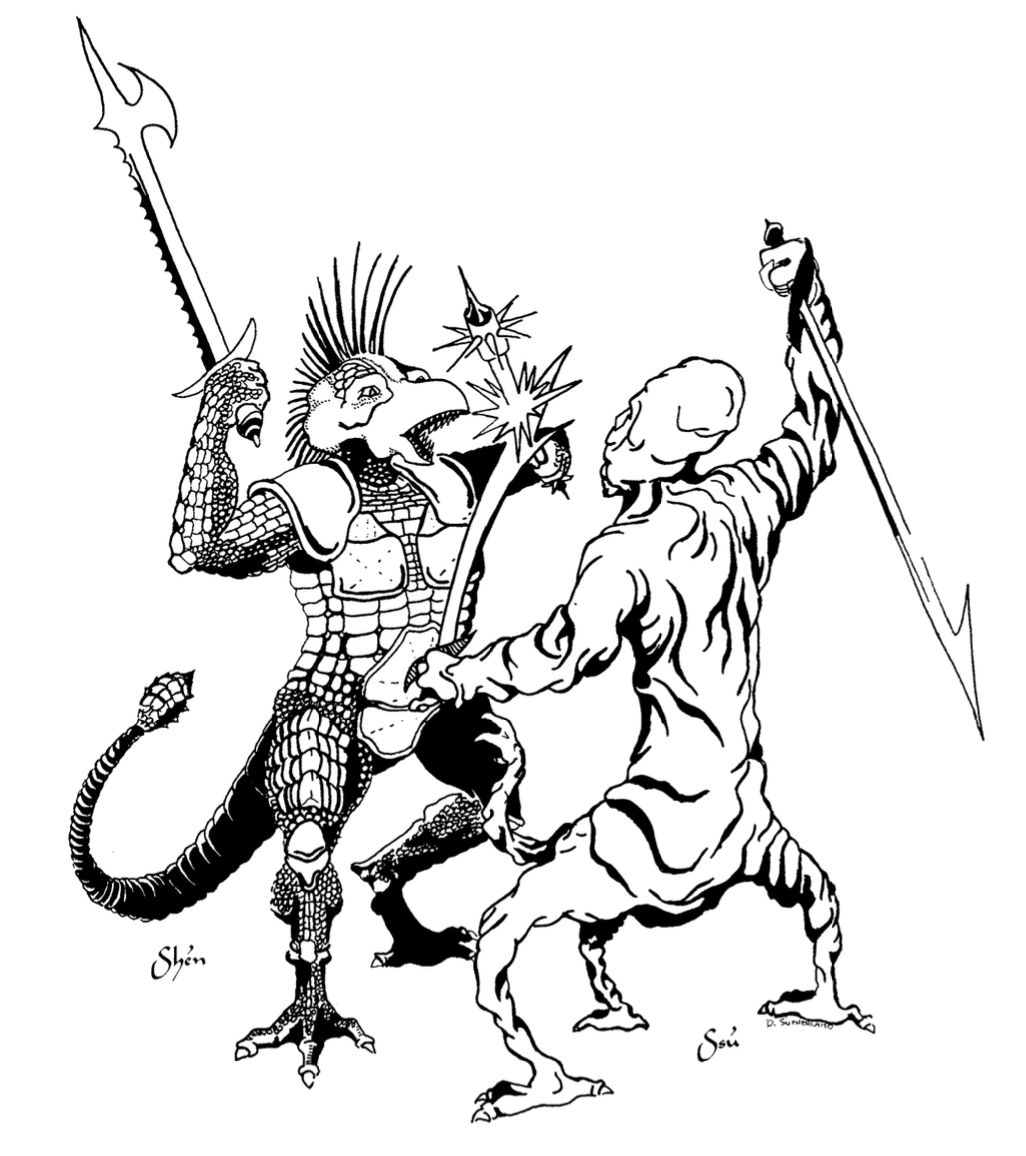 From Empire of the Petal Throne
From Empire of the Petal Throne
SM: There’s a deeper lore to Tékumel that involves the planet, it previously being a sort of pleasure world or theme park, which was cast off from the greater human galactic empire and now sits in its own sort of pocket dimension. How far in the background is this cosmological information in your campaign? Are the players aware of it in character or just as players? Do you find it has much relevance on the way your play?
JM: These sorts of details are fairly removed from what the characters know, though the players are (now) all aware of them. For the most part, the characters are still pretty ignorant of the full meaning of what they experience/encounter. To them, an android is just a magical automaton created by a sorcerer rather than a product of high technology. They view the world through the lens of Tsolyáni culture, which is utterly ignorant of the science fictional underpinnings of Tékumel. There’s a lot of fun to be had in the game when the players start to understand something their characters do not.
SM: I tend to really enjoy this friction between the players and the players characters which adds this extra dimension to gameplay. There’s another friction point I want to touch on, and that’s how has Barker’s recently discovered white supremacist sympathies affected things at your table? Have elements of the setting felt less to your taste, or does Tékumel feel like it “belongs to the table” now, so to speak? Has it altered the way you play? Or how you read into his work?
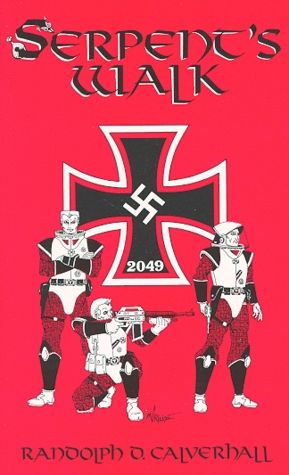 Serpent’s Walk, neo-nazi fiction written under MAR Barker’s pseudonym. I weirdly have actually held this book in a bookstore before I knew anything about Barker. I just saw it on the shelf and thought it looked weird.
Serpent’s Walk, neo-nazi fiction written under MAR Barker’s pseudonym. I weirdly have actually held this book in a bookstore before I knew anything about Barker. I just saw it on the shelf and thought it looked weird.
JM: Honestly, no. When the news first broke, we talked about it and not a single player expressed any concern. One of my players told me explicitly that he considered Tékumel “my” setting and that whatever Barker himself may have believed, it didn’t matter since I didn’t share those beliefs. Another player, who is German, told me that, having been taught as a child by many people who grew up under Hitler and having been involved in anti-Fascist protests in the ’80s, he had developed very sensitive “radar” to anything that smacked of Nazism. He assured me that he detected nothing in Tékumel that worried him. And that was pretty much that. Since then, I can’t say any of us have given it much thought. Tékumel is ours now.
SM: That’s maybe one of my favorite things about RPGs that I’ve long believed. The only “real” version of the game happens at the table. If Barker was alive and profiting off of EPT, I don’t think I’d support him financially. But at the end of the day whether it’s Cthulhu, or D&D, or Conan or whatever it may be when it hits the table the group has ownership over it.
I’m curious about language in your campaign. Tsolyáni is a pretty robust conlang. Do you keep a glossary close by? Have your players taken an interest in learning any? Language always feels handwaved in D&D but in Tékumel the clashing of cultures seems core to its identity. How has language shaped your gameplay?
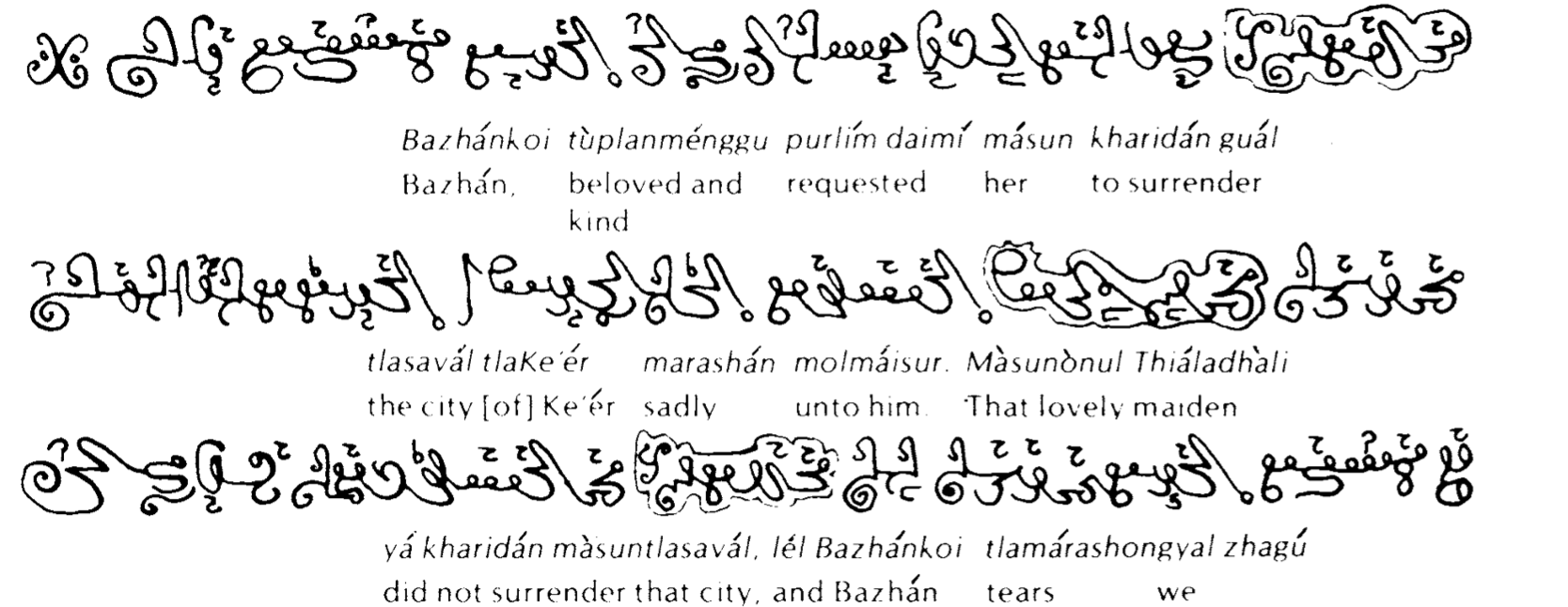 From Empire of the Petal Throne
From Empire of the Petal Throne
JM: We’ve never made significant use of Tsolyáni in our sessions beyond occasional references to certain words or phrases. However, the players have, over time, become somewhat familiar with certain aspects of the language, like its many forms of the pronoun “you.” Sometimes, a player will note that his character is addressing someone by means of a particular form of the pronoun, in order to convey whether he’s being deferential, affectionate, confrontational, etc. Sometimes, a player will even invent a new form of “you” in a joking way — I address him using “the you of sneering condescension” — but that’s generally the extent of how we use the language. That said, languages do play an important role in the game and which languages a character knows (or doesn’t) is taken into account. The characters regularly employ translators or spend time with tutors to acquire new languages. It’s not something we handwave at all.
SM: I love that! I’ve always felt language was left behind too often in my fantasy games and even just paying tribute to the reality of it in Tékumel sounds like it leads to some great moments. I’ve found that players having to solve minor logistical tasks (like finding a translator) really makes the game richer in a lot of ways.
You’ve been running your Tékumel game for years now. I think to a lot of people the “long game” is the platonic ideal for an RPG. I think for many people scheduling is the main obstacle. But beyond scheduling what have you found has worked for keeping your game and alive and thriving after so long? And how do you keep track of all the threads? A lot of referees I’ve talked to feel that after so many sessions there’s so many threads going so many ways that they can’t keep track and everything starts to feel handwaved. What works for you? JM: There are several factors that have contributed to the campaign’s longevity. The first and most important is that everyone involved in it for the long haul. We all looked on this, from the start, as a potentially never-ending campaign rather something shorter. That attitude has kept us going for seven years now and shows no signs of abating. Another important factor is that we always play — or at least try to — every week, month after month, year after year. Every session isn’t a transcendent experience and we don’t expect it to be. Each session adds another grain to the “pile” of the campaign and, over time, that pile acquires a weight and depth that helps keep things going. Now, the pile is big enough that, short of something momentous or a decision by everyone to stop, we could probably play indefinitely. As for keeping track of everything, we don’t. I do have a file of all the various NPCs the characters meet so I can reference it later. Other than that, we mostly rely on our memories, which inevitably means some details are forgotten and some threads fall away. We don’t sweat that too much, since all the important stuff — the things the characters care about — are easily remembered and often front and center.
SM: So you follow what’s at the forefront of players minds and let things fall where they may. Do you keep a calendar or plan out major events for the future? Do you ever run into a situation where it’s like “what about so and so?” “Oh whoops I guess uh. I guess that didn’t happen.” Or does that not tend to come up in your style of play? From your writing I get the sense that you have a very slice of life kind of pace where players are moving and interacting at a very natural pace rather than feeling like they need to clear a level of a dungeon or stop some ancient evil in two months. Not that there isn’t conflict but it sounds like the play itself is very smooth.
JM: I do keep a calendar, mostly so that I can track the passage of time. That’s important for a couple of reasons, starting with the major festivals of the Tsolyáni year. Knowing when it’s time for the Visitations of the Dormant Lord or the Uncovering of Wisdom or even just the summer solstice is important, because these can be opportunities for fun roleplaying and engagement with the setting. I also keep track of bigger events in the world, like wars or political struggles, and knowing the date helps me track their progress. Beyond that, I handle things with a flexible timeline based on our own sense of how long things should take. This is easier when lots of travel is involved, as it often is, because there’s an objective standard for how long it takes to get from point A to point B. When dealing with, say, an underworld exploration or political machinations in the city, it can be fuzzier but we try to keep one eye on the calendar. The pace of the campaign shifts between languid and accelerated depending on what the characters are doing and it’s worked very well. I can’t recall any time where we forgot about something significant and then later remembered it. Mostly, it’s little details or minor characters and, in those cases, we tend to err on the side of finding a way to work them back into the campaign once we remember them rather than excising them.
SM: I remember Oriental Adventures had a calendar for holidays and festivals and I think they’re some of the best bang for your buck in a long game. In terms of advancement, is there an incentive to become more powerful in the classic D&D sense or are players becoming more influential, better connected? Or are players actively trying to gain XP to learn new spells, that sort of thing?
JM: EPT differs from OD&D in that there’s an XP penalty as you level. At levels 1-3, you get full XP; at levels 4-5, you get 50%; at levels 6-7, you get 25%, etc. That means advancement tends to stall around levels 5-7, because of how much XP you need to gain a new level. Like OD&D, XP is gained from defeating enemies and finding treasure, so there’s already a limit placed on how much XP you’ll gain in a campaign that’s not obsessively focused on dungeon delving, as mine is not. After 7 years of play, the highest level character is level 7; most characters are levels 5-6. Consequently, most “advancement” in the campaign is non-mechanical and the result of social/political maneuvering. One PC is the governor of a colony, another is the general of the local militia, others have roles in their temples, and so on. They still do a lot of what might be called “adventuring” — exploring ruins, fighting monsters, investigating mysteries — but most of their advancement within the setting is social and has little to do with game mechanics.
SM: This is something I really enjoy in games like Traveller for instance which features very little mechanical advancement. In many ways I think mechanical advancement obscures what I love about RPGs: this feeling that you can experience new things, make new allies, solve interesting problems, all just by using your imagination rather than relying on a twice a day super power. I also like a flat power curve so you don’t get into the “bigger swords to fight bigger goblins” problem. So flattening out around 5-7 seems like it would keep adventuring perilous while still allowing players to grow (into governors, etc.). Finally, I wanted to ask about the future of EPT. As I understand it the Tékumel foundation is primarily concerned with preservation rather than expansion and the new revelations absolutely Barker’s sympathies I imagine are making things difficult for a big renaissance. I also think it’s possible that you’ve run the most games of Tékumel other than the professor himself. All that being said, if someone was interested in EPT where would they start? Are there any other fans out there creating anything interesting? JM: If someone were interested in Tékumel, I would recommend first taking a look at the original Empire of the Petal Throne. It’s available as an inexpensive PDF or print-on-demand book at DriveThruRPG. It’s relatively short (about 120 pages) and contains everything you need to get a taste of the setting. Rule-wise, it’s based heavily on D&D, so it should be quite accessible to anyone already familiar with that game. If, after having looked at EPT, you want to know more, go ahead and pick up the Tékumel Source Book, also from DTRPG. This is a much heavier book, almost academic in its tone and presentation. But it also gives you plenty of additional detail about almost any topic you can imagine — history, languages, religion, magic, etc. You don’t need the Source Book, but it’s useful if you’re keen to learn more. I refer to it a lot in my campaign, but I don’t have it memorized and neither should you. As for new Tékumel material, there’s not a lot. Jeff Dee has published Béthorm, which is an original RPG set on Tékumel and offers some support for it in terms of a couple of adventures and a big sourcebook. There’s also my own fanzine, The Excellent Travelling Volume, which focuses on gameable stuff for Tékumel, like new species, character classes, magic, locations, and scenarios. There are 13 issues so far. Beyond that, there’s not much else new, but, honestly, you don’t need more than the original EPT and your own imagination.
SM: I think that’s my big takeaway which is that Tékumel isn’t some precious setting that you should be afraid to engage with, rather it’s an invitation to come and see what you find. After all Tékumel belongs to us now.
Previous post
What I’m Working OnA lots going on in the Motherverse. We went from producing a zine a year roughly to now having something like six plus books due this year and a...
Next post
The First Line of Every Edition of Dungeons & Dragons“ONCE UPON A TIME, long, long ago there was a little group known as the Castle and Crusade Society.” – Dungeons & Dragons (1974), “Foreward” (sic)...
Copyright © 2018 Failure Tolerated